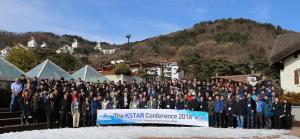Fusion world
210 papers presented at KSTAR conference
19 Mar 2018
-
Ji-Min Song, ITER Korea
The superconducting tokamak KSTAR has been in operation at the National Fusion Research Institute in Daejeon, Korea, since 2008. The KSTAR conference, held annually, offers scientists from around the world the opportunity to exchange information on joint experiments and engineering activities at KSTAR and other fusion devices, as well as to discuss the current status of ITER, fusion power plant design, theory, basic plasma research and application.
The 2018 edition, held from 21 to 23 February in Muju, Korea, continued the tradition, with 287 participants (including 46 researchers from abroad) and 210 papers presented.
The 2018 edition, held from 21 to 23 February in Muju, Korea, continued the tradition, with 287 participants (including 46 researchers from abroad) and 210 papers presented.
There were detailed reports on the research highlights achieved on KSTAR, the domestic program for ITER in Korea, and the K-DEMO program—a forward-looking development program for the device after ITER. Plenary talks were also given by invited speakers on the European tokamak JET, the LHD stellarator (Japan), and the ASDEX Upgrade tokamak (Germany).
State-of-the-art fusion research was highlighted in discussions on steady-state high-performance operational scenarios, 3D physics on ELM suppression, and disruption mitigation—with special sessions for promoting KSTAR collaborative research in these areas with the Princeton Plasma Physics Laboratory (US) and the Fusion CDT doctoral program in the UK.
The presentations of young scientists on challenging research areas were also a highlight of the 2018 KSTAR conference.


